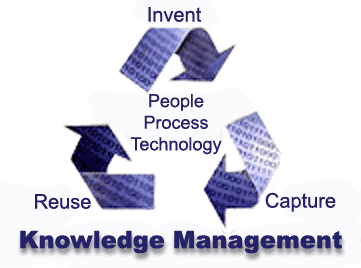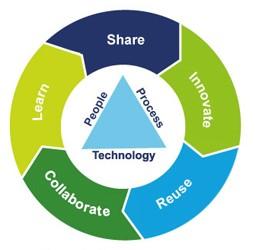Lucidea’s Lens: Gartner Comparison, Part 2 – Exploring the 7 Cs

Stan Garfield
In Part 1 of this series, I listed Lucidea’s 5 Cs of KM, Gartner’s Four Cs of KM, and the five activities of Gartner’s KM Process Framework. The three lists have a lot in common but have a few differences. In this post I will compare them in detail.
Lucidea’s 5 Cs of KM
- Capture: Collecting documents, presentations, spreadsheets, records, processes, software source code, images, audio, video, and other files that can be used for innovation, reuse, and learning.
- Curation: Taking existing information and making it more useful by better organizing it, making it more findable, and making it easier to use.
- Connection: Connecting people to people through communities, Enterprise Social Networks (ESNs), and expertise locators; people to content through navigation, search, and tagging; and content to content using taxonomy, a thesaurus, and links.
- Collaboration: Interacting with peers and colleagues to enhance content, share and reuse knowledge, work together, and solve problems in work teams, project teams, and communities.
- Creation: Inventing and innovating new concepts, approaches, methods, techniques, products, services, and ideas that can be used for the benefit of people and organizations.
Gartner’s Four Cs of KM
- Converse: Connecting people who need knowledge directly with the people who possess that knowledge. Conversation, mentoring, observation, and joint practice are among the most effective ways to transfer knowledge. These interactions are also key to refining and extending existing knowledge and generating new ideas and approaches.
- Capture: Knowledge-based articles, wikis or best-practice documents are all useful repositories of externalized expertise that can preserve and present expertise, even when the source of that expertise is unavailable.
- Curate: Content must be edited, organized, fleshed out, updated, and eventually retired. Community members must comment, refine, and elaborate on knowledge resources.
- Circulate: Content should be proactively disseminated to interested parties, and users must have the means and opportunities to consume, consider, and share knowledge resources.
Gartner’s KM Process Framework
- Creation: Creating new knowledge or new assemblies of existing knowledge.
- Capture: Turning knowledge that is resident in the mind of the individual into an explicit representation available to the enterprise.
- Organization: Classifying, categorizing, and maintaining knowledge for navigation, storage, and retrieval.
- Access: Retrieving or disseminating knowledge.
- Use: Applying knowledge to business decisions or opportunities.
Comparing the Lists
Gartner’s April 28, 2022 report, Guidance for Developing a Knowledge Management Strategy, modified the list of KM activities from their June 25, 1998 KM Process Framework. “Capture” is the only one in common. “Curate” maps to “Organization” and “Circulate” maps to “Access.” “Converse” was added and doesn’t directly map to anything in the earlier list. “Creation” and “Use” from the earlier list are missing in the newer list.
Gartner’s Four Cs and Lucidea’s 5 Cs have two in common: “Capture” and “Curation.” “Converse” maps to “Connection” and “Collaboration.” “Creation” is missing from Gartner’s list and “Circulate” is missing from Lucidea’s list.
The Seven Cs
1. Capture
All three lists include this activity. Also referred to as collection, it is a necessary part of KM, providing the supply side of knowledge.
2. Curation
Two of the three lists include this activity, and the earlier Gartner list has it as “Organization.” It represents a key role of knowledge managers, taxonomists, and community managers in making knowledge more readily available and reusable.
3. Connection
Only included in Lucidea’s list, this is the complement to capture/collection. “Converse” and “Circulate” are part of connection, but do not fully represent connecting people to people, people to content, and content to content.
4. Collaboration
Only included in Lucidea’s list, this is a fundamental knowledge management activity. “Converse” and “Use” get at part of collaboration but omit key parts of it. “Converse” and “Use” leave out working together and “Converse” misses reuse.
5. Creation
Two of the lists include this process, and “Converse” in Gartner’s newer list mentions generating new ideas and approaches. Invention and innovation are generally considered so important that creation warrants inclusion as one of the Cs.
6. Converse
This is only included in the latest Gartner list but is a key part of “Connection” and “Collaboration” in the Lucidea list. As the title of Nancy Dixon’s blog says, conversation matters. Lucidea has featured many KM Conversations and I have written several articles about conversation.
7. Circulate
This is only included in the latest Gartner list but is part of “Access” in the earlier Gartner list. I have written extensively about communications and specifically about the pros and cons of push communications. It is included in “Curation” in making content more findable and in “Connection” as connecting people to content.
The concepts of recycle and circulate are reflected in two of the icons I have used to represent knowledge management: the Invent/Capture/Reuse cycle and the Share/Innovate/Reuse/Collaborate/Learn circle (SIRCL):


In my next post, I will compare the other details of the recent Gartner report with similar concepts I have written about for Lucidea’s Think Clearly Blog.

Stan Garfield
Please enjoy Stan’s blog posts offering advice and insights drawn from many years as a KM practitioner. You may also want to download a copy of his book, Proven Practices for Implementing a Knowledge Management Program, from Lucidea Press. And learn about Lucidea’s Presto and SydneyEnterprise with KM capabilities to support successful knowledge curation and sharing.
Never miss another post. Subscribe today!
Similar Posts
Lucidea’s Lens: Knowledge Management Thought Leaders Part 106 – Hubert Saint-Onge
As the creator of the Knowledge Assets Framework Hubert has shaped how businesses integrate strategy leadership and knowledge sharing to drive performance.
Lucidea’s Lens: Knowledge Management Thought Leaders
Part 105 – James Robertson
James Robertson is a pioneer in intranet strategy and digital workplace design helping organizations create seamless employee experiences. As the Founder of Step Two and a respected industry voice he has shaped best practices in content management portals and digital experience design.
Lucidea’s Lens: Knowledge Management Thought Leaders
Part 104 – Vincent Ribière
Vincent Ribière advances knowledge and innovation management through AI creativity and KM. Explore his work in academia research and industry leadership.
Lucidea’s Lens: Knowledge Management Thought Leaders Part 103 – Tony Rhem
In this edition of Lucidea’s Lens: Knowledge Management Thought Leaders we highlight Dr. Tony Rhem a leading expert in AI big data information architecture and innovation. As CEO of AJ Rhem & Associates Tony has shaped the fields of knowledge management governance and emerging technologies.





Leave a Comment
Comments are reviewed and must adhere to our comments policy.
0 Comments